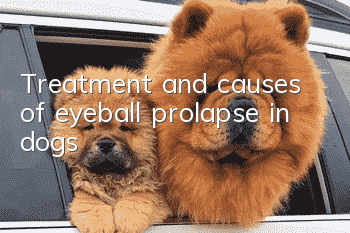Treatment and causes of eyeball prolapse in dogs

Every dog has a pair of bright, big eyes. Eyes are one of the indispensable facial features of a dog, but they are also the part that is prone to disease. The normal eyeball of a dog is embedded in the eye socket, and the dog can open or close its eyes. However, under special circumstances, the dog's eyes will be injured, causing eyeball prolapse in dogs. So what is the cause of eyeball prolapse in dogs? And how to treat it?
Basset Hound
1. Causes of dog eye prolapse
The cause of this disease is genetics. Some dogs with shallow eye sockets (such as Pekingese and Shih Tzu) often suffer from eye prolapse due to excessive excitement. In addition, head trauma, dog bites, and fractures of the bones around the eye socket for various reasons can also cause eyeball prolapse.
2. Treatment of dog eye prolapse
The eyeball is an organ that needs moisture at any time. If this happens, in addition to seeking immediate medical attention, if you cannot seek immediate medical attention, you should follow the following principles
1. Fully moisturize and clean: Use clean water (boiled water, mineral water) or saline solution (contact lens rinse solution) to moisten and clean the eyeballs first, and keep the eyeballs moist at all times.
2. Strictly prohibit dogs from scratching their eyeballs: When the eyeballs prolapse, the dog itself will be quite uncomfortable. The reflex action is to use the feet to fiddle with the prolapsed eyeballs, causing secondary injuries.
3. It is strictly prohibited to put pressure on the eyeball. When the eyeball prolapses, it is often accompanied by corneal ulcer or perforation. If pressure is applied, the fluid in the eyeball will often leak out and cause irreversible damage to the eyeball.
3. Risks of treatment for dog eye prolapse
In some cases, vision can be severely affected.
1. If the prolapse lasts for too long, more than 2 hours, you will often become blind due to the obstruction of blood circulation in the eyeball.
2. Secondary injury, causing eyeball rupture and anterior chamber fluid outflow.
3. Structural abnormalities of the crystalline lens and retina.
4. When the pupillary reflex disappears, it is because the nerve damage is quite serious.
- How is the Tibetan Mastiff trained? Tibetan Mastiff training methods!
- Judgment criteria and treatment principles for small dogs
- How to treat paralysis in dogs
- What should you pay attention to when shaving your poodle? Tips for shaving your poodle!
- Things to note when raising a Teddy dog
- Understand these benefits of neutering dogs so that people will no longer misunderstand it as "abuse"
- What causes pregnancy bleeding in dogs?
- Several points to note when choosing a Yorkshire puppy
- Can dogs drink soy milk?
- There is yellow pus in the urethral opening of the dog



